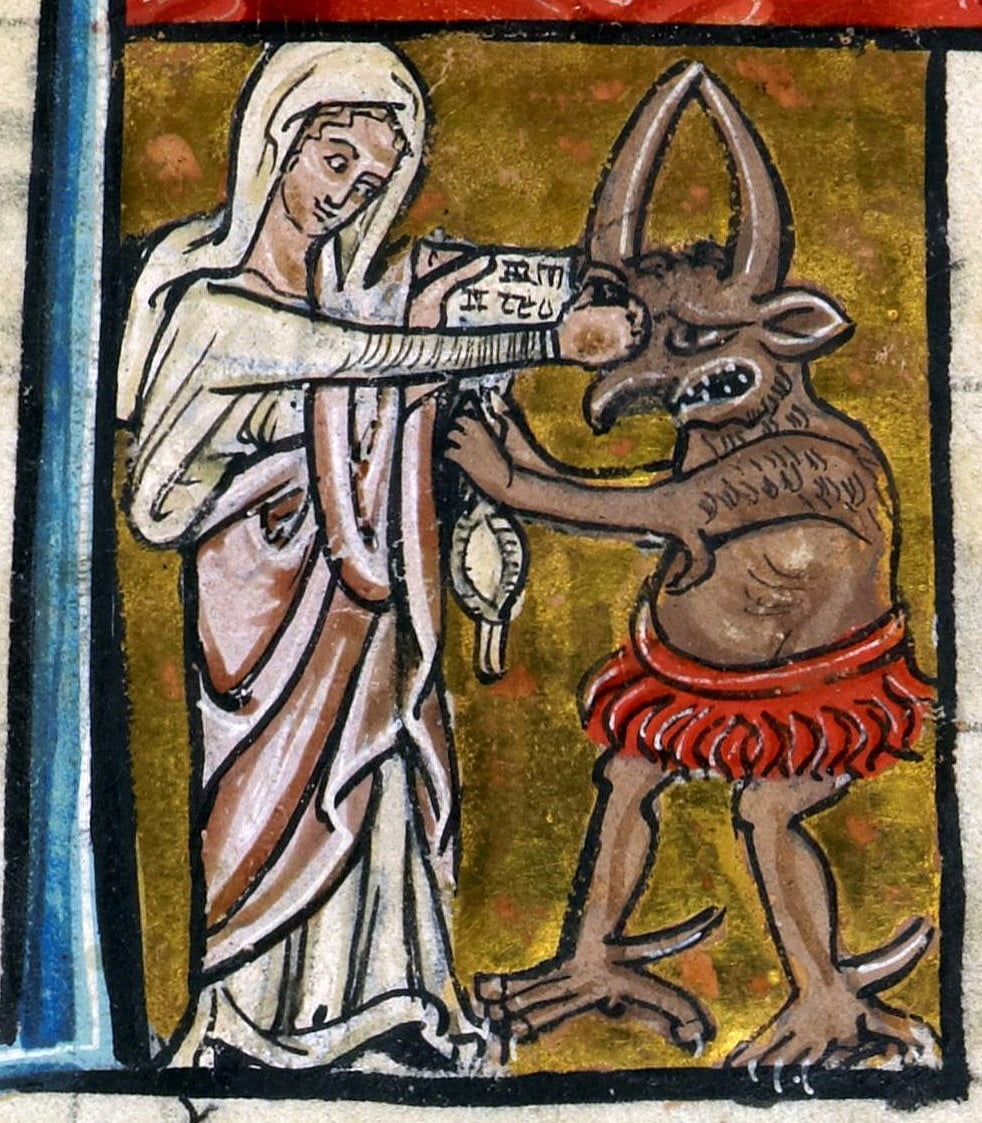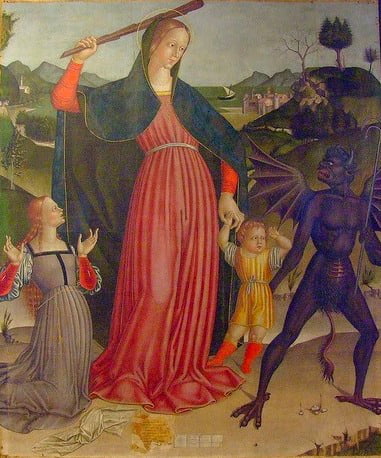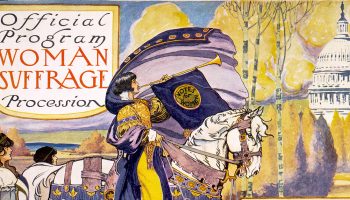This is Part 4 of The Public Medievalist‘s special series: Gender, Sexism, and the Middle Ages, by Vanessa Corcoran. You can find the rest of the series here.
As a medieval historian—arguably a pretty niche field—there is a singular thrill when a medieval image or news story captures the interest of a broader audience. My specialty being the veneration of the Virgin Mary, I was delighted when a manuscript illumination went viral in 2017 with the following introduction: “Please enjoy this image of the Virgin Mary punching the devil in the face.”

I received countless text messages asking, “Have you seen this??” People were shocked to see the Virgin Mary in such an assertive posture. Wasn’t the Mother of God praised for her serene nature?
I was, in fact, very familiar with this image—my dissertation included numerous illustrations of Mary attacking the devil, as well as countless textual examples of Mary using her voice as a powerful instrument or even a weapon. Withering flower, she was not. A myriad of prayers, hymns, sermons, and other devotional practices imagined Mary speaking profusely to her supplicants. Yet Mary, arguably the most famous woman in Western history, only spoke in the Bible on four occasions (Luke 1:26-38, 1:46-56, 2:41-52, and John 2:1-11). Why then did late medieval authors and artists opt to depict her as a powerful woman who spoke “severely” to her supplicants, intoning, for example, “Thou hast provoked me to great anger?”
It struck me as a contradiction that the Virgin Mary—known as the Mother of God, Queen of Heaven, and a literal litany of other titles, and who inspired a rich profusion of religious devotion and culture—is only documented in the Bible speaking fewer than 200 words. Despite this, observations about Mary’s eloquent voice was frequent in a series of later medieval devotional sources. Mary’s voice was regarded as provocative, and was often shaped to reflect or even satirize broader medieval social and religious concerns.
How can this assertion be reconciled with the notion that medieval Christian culture sought to limit women’s speech, essentially silencing female voices in society and from historical records?
“All the women of the township (should) control their tongues”
Medieval culture did restrict women’s speech. This concern for monitoring and regulating women’s speech had its roots in early Christian texts. As a justification, preachers and theologians cited 1 Corinthians 14:34, wherein Paul wrote:
Women should keep silent in the churches, for they are not allowed to speak, but should be subordinate, as even the law says. But if they want to learn anything, they should ask their husbands at home. For it is improper for a woman to speak in the church.
Taking their cue from Paul, medieval theologians encouraged husbands to monitor their wives and limit their public communication.
Women particularly had their speech restricted during religious rituals. In late medieval Christian society, an important part of religious life was the ritual of communal mourning, where a community would publicly mourn someone who died. But even in this context, medieval Christian women’s behavior was often viewed as disruptive or dangerous. Narrative accounts of funeral processions described women who sobbed, screamed and even writhed on the ground. But these public lamentations were met by attempts by men to silence the mourning women. Famed Italian humanist Francesco Petrarch viewed this effusive weeping as full of “loud and uncontrolled shrieks,” and ordered Francesco da Carrara, lord of Padua, to require “that no women should set foot outside her house.” Instead, he insisted that women mourn behind closed doors: “If weeping is sweet for those in misery, let her weep at home to her heart’s content, and not sadden the public spaces.” Apparently even the civic authorities thought it their place to tell women to smile more.

Across a range of written sources, authors stressed that silence was the gold standard for women. Two fourteenth-century English towns even attempted to enforce female silence. One court roll records a case in which demanded that “all the women of the township control their tongues,” and the other “enjoined upon all the women in the township that they should restrain their tongues and not scold nor curse any man.” Although these declarations were never made into public policy, these efforts demonstrated that women’s speech was regarded as dangerous and destabilizing.
Gossip was even criminalized: women in fifteenth-century England faced court charges for “speech abuses.” In 1425, after yelling in a tavern about, reportedly, a stolen pan, one Agnes Le Spenser (who called Thomas Batesson a thief, along with several “other dishonest names”) was fined 12 pennies. Scolding, a form of defamation, became a feminized crime in the later Middle Ages, with several women prosecuted as scolds in the fourteenth and fifteenth centuries. One could easily imagine that TMZ would routinely face fines for some of their more salacious stories—especially if they were headed by a woman.
The importance of speech (or lack thereof) in defining femininity also pervaded popular literature, where instructional manuals taught how women ought to speak and behave. For example, The Good Wife’s Guide was a popular fourteenth-century “how-to” guide for medieval women. It encouraged women to view humility, obedience, and succinctly eloquent speech as estimable qualities. Moreover, the narrator of the text stringently discouraged gossip: “Be silent or at least to speak sparingly and wisely so as to protect and conceal your husband’s secrets.” Within medieval society, husbands were legally responsible for their wives and had to account for any illicit behavior. Social manuals like The Good Wife’s Guide entreated wives to show total deference to their husbands: “Do not be arrogant or answer back to your future husband or to his words and do not contradict him, especially in front of others.” Books like The Good Wife’s Guide make Mary’s forceful, vocal role in medieval writing all the more substantial.
“I am also empress of hell, and have power over all you enemies”

As I mentioned, Mary had many, many titles. Some of those titles, like “Mother of Mercy” and “Queen of Heaven,” may be familiar to Catholics today. But some of her medieval titles, like Empress of Hell [ed note: seriously, look it up, some medieval people called Mary the Empress of Hell], seem to contradict to the idea of the serene Madonna. Medieval theologians thought of Mary differently than we do. They imbued Mary with incredible power: the ability to influence the highest heights and lowest depths of the afterlife.
For example, St. Anselm of Canterbury (1033-1109) praised Mary’s ability to save the condemned from hell:
O woman marvelously unique and uniquely marvelous through whom the elements are renewed, hell is redeemed, the demons are trampled under foot, humanity is saved, and angels are restored.
Conrad of Saxony extolled Mary’s extensive power, noting: “You are a wonderful warrior, every soldier of the evil spirits is put to flight before your face.” Pope Honorius III (r. 1216-1227) addressed Mary’s power against the devil in his Second Sermon for the Feast of the Assumption: “For the demons, Blessed Mary was terrible as an army arrayed for battle… [saying]‘I am terrible for my enemies.’” Finally, several medieval miracle collections (devotional narratives that praised the deeds of a saint) explored this idea at length; they framed Mary as a skilled warrior who successfully vanquished the devil. This particular representation became increasingly popular—in tandem with her the title “Empress of Hell”—in fourteenth-century England. In this unique role, Mary descended into hell in order to do battle to save souls from damnation.

You can also see Mary’s power over the devil on display in the popular medieval legend of Theophilus. This legend dates back to the sixth century, and the basic story provided the framework for the Faust legend: a cleric named Theophilus makes a pact with the devil and renounced Christ and Mary in a contract written in his own blood. Recognizing the error of his ways, Theophilus sought Mary’s aid to overturn the agreement. Mary tore up the contract, and saved Theophilus’s soul.
This legend was retold with many variations numerous times. In many of the medieval retellings of this legend, Mary does not just condemn the devil with her words, but issues corporal punishments that reinforce her authority. In his twelfth-century Marian miracle collection, William of Malmesbury wrote that Mary beat the devil with a stick,
redoubling her blows and making them sharper with words, ‘Take that, and go away. I warn you and order you not to harass my monk any more. If you dare to do so, you will suffer worse.’
In other cases, Mary is imagined skillfully debating with the devil. In the late thirteenth/early fourteenth-century Gesta Romanorum, Mary commands the devil to release a woman from his clutches: “You devil, are a most wicked thief.” The fourteenth-century Queen Mary Psalter offers an illustrated version of this story. While the devil attempts to debate with her, Mary is the commanding figure, who raises her hand as if to dismiss him. Mary’s imposing authority ultimately triumphs.

Medieval narratives also addressed the ways in which the devil reacts to the displays of Mary’s power. In response to Mary’s appearance in hell, the devil (in the version of the Theophilus legend found in the South English Legendary written around 1290) refers to Mary as his “worst enemy.” Enraged, the devil continues his tirade against Mary exclaiming, “You overpower us all! Alas that you ever existed!” Maintaining her composure, Mary banishes the devil: “I command that you go away, that you never come near this man to shame him again.”
The Virgin Mary did not always act as the “Mother of Mercy.” At times, medieval authors envisioned her speaking harshly to urge Christians to change their behavior. This assertive persona was so striking that, in his collection of Marian miracles, Caesarius of Heisterbach noted that “She spoke to him [a priest] severely” and threatened, “I will take away from you the use of your tongue.”` Medieval society sought to silence women. But Mary was thought to have enough power to turn the tables.
Breaking Through the Silence
Looking back to the present, in February 2017, during confirmation hearings for Attorney General Jeff Sessions, Senate Majority Leader Mitch McConnell silenced Senator Elizabeth Warren for reading a letter from the late Coretta Scott King. He infamously defended his actions by insisting, “She was warned. She was given an explanation. Nevertheless, she persisted.” This instantly turned into a rallying cry of resistance. #ShePersisted trended. Against it were placed images of female pioneers such as Malala Yousafzai, Rosa Parks, Harriet Tubman, and even Princess Leia. Then the image of Mary punching the devil was turned into a meme that included the quote or hashtag. Mary’s attack on the devil upends the conventional idea of the demure Madonna and instead shows a medieval woman unapologetically asserting her power.
In 2017, the roar of women’s voices was heard through the streets in the global Women’s March, and only grew as the #MeToo movement saw women break their silences about sexual assault and harassment. When Professor Christine Blasey Ford testified before the Senate Judiciary Committee in September 2018 about her allegations of sexual assault against then-Supreme Court Nominee Brett Kavanaugh, she gave a voice to the voiceless and galvanized a national movement. On the day of her testimony, calls made to the National Sexual Assault Hotline rose 147 percent. One consequence of the #MeToo movement is the recovery and sharing of stories that have thus far gone untold (or not believed).
Recovering the voices of women in medieval sources is not easy, as the sources are primarily authored by educated male members of the clergy who often represented the upper echelons of medieval society. Women-authored texts comprise only a small percentage of the medieval canon. A similar gender gap remains in today’s media landscape. But amid the large gaps in women’s representation in historical documents, we must listen carefully to the texts, including observing the silences, to understand how medieval women were expected to speak and behave. When we aim to recover those whispers from the past, we can better appreciate the complex and multifaceted roles that women occupied, even those positions that were imposed upon them.
If you enjoyed that article, please share it with your history-loving friends on Facebook, or on Twitter! And be sure to subscribe here to receive every new article from The Public Medievalist the moment it launches.




